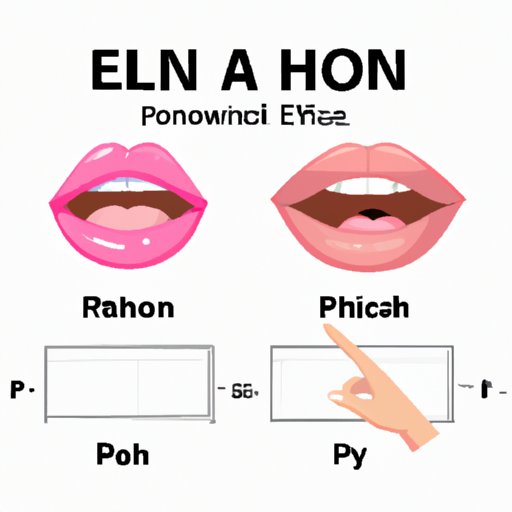
I. Introduction
Are you struggling with how to pronounce the word “what”? Mispronouncing words can be frustrating, especially when you’re trying to communicate clearly in a new language. But fear not, with a little practice and some techniques, you can perfect your pronunciation of “what” and many other words in the English language. In this article, we’ll explore the techniques to accurately pronounce “what” in different dialects, identify common mistakes, provide tips on emphasizing the correct vowel sound, and offer guidance for receiving feedback and correction.

II. Understanding the IPA Phonetic Alphabet for “What”
The International Phonetic Alphabet (IPA) is a system of phonetic notation that uses symbols to represent the sounds of spoken language. Using the IPA, we can break down the word “what” into individual sounds and learn how to correctly pronounce them.
The IPA symbols needed to pronounce “what” are /w/ and /ɒ/. The /w/ sound is a voiced labial-velar approximant, which is made by roundly protruding the lips and bringing them together, while at the same time articulating the tongue toward the soft palate. The /ɒ/ sound is an open back rounded vowel, which is made by rounding the lips, opening the mouth, and articulating the back of the tongue toward the back of the mouth.
When pronouncing “what,” start with the /w/ sound and then quickly move to the /ɒ/ sound. The two sounds should flow seamlessly together for proper pronunciation. For a more detailed explanation and audio examples, check out this video.
III. Techniques for Pronouncing the “W” Sound in “What”
The “W” sound in “what” can be tricky for non-native English speakers, especially those whose native language doesn’t contain this sound. Here’s a breakdown of common mistakes and step-by-step instructions for correctly pronouncing the “W” sound:
A. Explanation of common mistakes with the “W” sound
One common mistake is to pronounce the “W” sound like a “V” sound. This is because some languages use the same sound for both letters. Another mistake is to round the lips too much, which can produce a sound closer to “O” instead of the correct “W” sound.
B. Step-by-step instructions for correctly pronouncing “W”
Here’s a step-by-step guide for pronouncing the “W” sound:
- Part your lips slightly into a small oval shape. Your lips should not touch or completely round.
- Push your breath out and towards your lips.
- Bring your lips closer together, but not touching. The sound should be voiced and continuous, like a hum.
C. Examples of words with the “W” sound
Here are some words to practice your “W” sound:
- water
- window
- wine
- warm
- wonderful
IV. Comparing Pronunciations in Different English Dialects
English is spoken in many different countries, and as a result, there are many different dialects of the language. Here’s a comparison of the “what” pronunciation in American, British, and Australian English:
A. Explanation of regional differences and dialects
In American English, “what” is pronounced as “wut” with a short “u” sound. In British English, “what” is pronounced as “wot” with a short “o” sound. In Australian English, “what” is often pronounced as “whut” with a long “u” sound.
B. Comparison of “what” pronunciation in American, British, and Australian English
Here’s a comparison of the pronunciation of “what” in different English dialects:
- American English: wut
- British English: wot
- Australian English: whut
C. Examples of differences in pronunciation
Here are some examples of words with a different pronunciation in each dialect:
- Caramel: kar-uh-mel (American English), kar-muhl (British English), kaa-ruh-mel (Australian English)
- Basil: bay-zuhl (American English), baz-uhl (British English), baz-uhl (Australian English)
- Aluminum: uh-loo-muh-num (American English), uh-loo-min-um (British English), yoo-luh-min-ee-um (Australian English)
V. Tips on Emphasizing the Correct Vowel Sound in “What”
Vowel sounds can be difficult to master in a new language, but with some attention and practice, you can perfect your “what” pronunciation. Here are some tips for emphasizing the correct vowel sound:
A. Explanation of common mistakes with vowel sounds
One common mistake is to pronounce the vowel sound too quickly or too slowly, which can result in an incorrect sound. Another mistake is to emphasize the wrong part of the sound, such as emphasizing the beginning instead of the end.
B. Step-by-step instructions for emphasizing the correct vowel sound
Here are some tips for emphasizing the correct vowel sound in “what”:
- Start by listening carefully to native speakers and paying attention to the specific sounds they make.
- Practice the vowel sound slowly at first, and then gradually speed up while maintaining the correct sound.
- Focus on the ending of the sound, which is where the emphasis should be.
- Record yourself speaking and listen back to identify areas where you need improvement.
C. Examples of words with similar vowel sounds
Here are some words with a similar vowel sound to “what” that you can practice:
- watch
- want
- whatsoever
- swatch
- wand
VI. Using Mouth Exercises to Train and Improve Pronunciation
Mouth exercises can help you strengthen the muscles used for speaking and improve your overall pronunciation. Here’s a guide to mouth exercises specifically for “what” pronunciation:
A. Explanation of the importance of mouth exercises
Mouth exercises help to build the muscles and coordination needed to speak clearly and accurately. They can also help to reduce anxiety and improve confidence in speaking.
B. Step-by-step guide to mouth exercises
Here’s a simple mouth exercise to improve “what” pronunciation:
- Purse your lips together tightly like you’re going to whistle.
- Blow air out through your pursed lips, making a soft “W” sound.
- Hold the sound for a few seconds, making sure the “W” sound is continuous.
- Repeat the exercise several times.
C. Examples of exercises specifically for “what” pronunciation
Here are some other mouth exercises you can try to improve your “what” pronunciation:
- Repeat the sound “Wuh” slowly and clearly, gradually speeding up until you can say it quickly and accurately.
- Practice speaking in front of a mirror, paying close attention to the shape and movement of your mouth.
- Read aloud from a book or newspaper, paying attention to your pronunciation and correcting any mistakes as you go.
VII. Common Mistakes to Avoid
Here are some common mistakes to avoid when pronouncing “what”:
A. Description of common mistakes when pronouncing “what”
- Mispronouncing the “W” sound as a “V” sound.
- Mispronouncing the vowel sound as an “O” or “U” sound.
- Emphasizing the wrong part of the word, such as the beginning instead of the end.
B. Explanation of why these mistakes occur
These mistakes can occur due to differences in the sounds used in a person’s native language or differences in dialects of English.
C. Tips for avoiding these mistakes
To avoid these mistakes, it’s important to practice and listen carefully to native speakers. Pay attention to the specific sounds used in “what” and other words and focus on training your mouth muscles to create those sounds accurately.
VIII. How to Receive Feedback and Corrections
Receiving feedback from others can be a valuable tool for improving your pronunciation. Here’s how to receive feedback and use it to your advantage:
A. Explanation of the importance of feedback
Feedback can help you identify areas where you need improvement and provide guidance on how to correct mistakes.
B. Tips for finding someone to provide feedback
You can ask a friend, family member, or language tutor to provide feedback on your pronunciation. You can also seek out language exchange programs or online communities where you can connect with native speakers for feedback.
C. Suggestions for how to practice based on feedback received
Once you receive feedback, take it as an opportunity to learn and improve. Practice the specific sounds or techniques that were identified as needing improvement, and record yourself speaking to track your progress over time.
IX. Conclusion
Improving your pronunciation of “what” and other English words takes practice and patience, but it’s worth it to communicate clearly with others. By understanding the IPA Phonetic Alphabet, practicing mouth exercises, and receiving feedback, you can perfect your “what” pronunciation and speak English more confidently. Remember to practice regularly, seek out feedback, and be patient with your progress.





